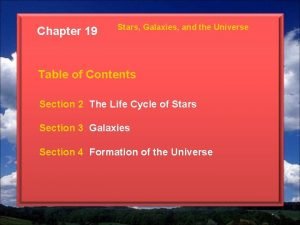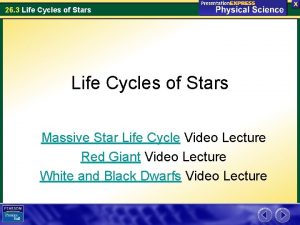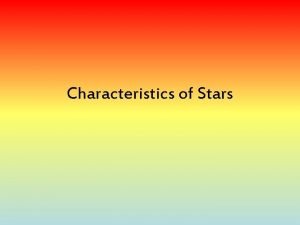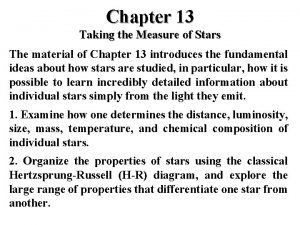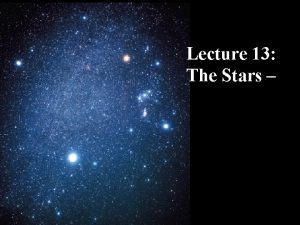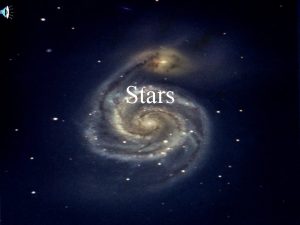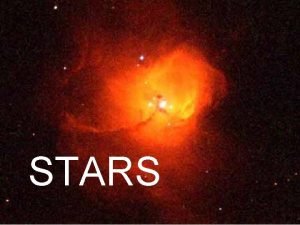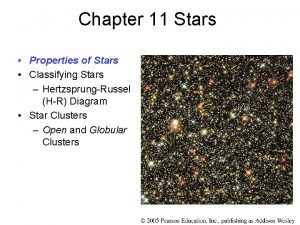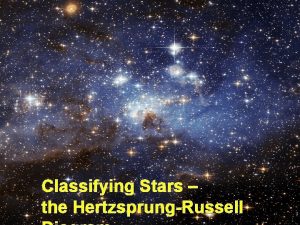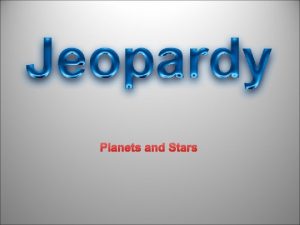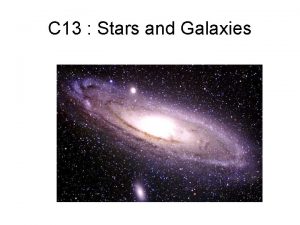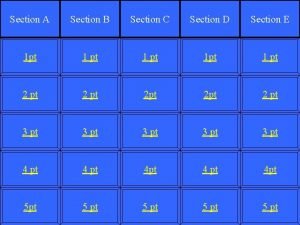Stars SECTION 26 2 What Are Stars Stars

















- Slides: 17

Stars SECTION 26. 2

What Are Stars? Stars are a large, glowing ball of gas in space, and it generate energy through nuclear fusion in its core. The closest star is the sun.

Distances to the Stars The Light Year- Scientists measure distances between stars in this matter. A light year is the distance that light travels in a vacuum in a year.

Distances to the Stars(cont. ) Scientists have different methods of measuring distance. One method is to observe stars from two different positions in relation to a background, which is known as a parallax.

Distances to the Stars (cont. ) Before telescopes, scientists couldn’t measure position the stars accurately. Now, scientists will measure the parallax of nearby stars to determine their distance from Earth. The closer a star is to Earth, the greater its parallax.

Properties of Stars How do astronomers classify stars? 1) Color 2) Size 3) Brightness 4) Chemical Composition 5) Mass

Color and Temperature The hottest stars, have surface temperatures at 30, 000 Kelvin and appear to be blue. Relatively cool red stars are 3, 000 K. Stars between 5, 000 and 6, 000 K appear yellow.

Brightness A star’s brightness as it appears from Earth is called its apparent brightness, and it decreases as its distance from you increases. Absolute brightness is how bright a star really is and it does not depend on the stars distance. You calculate it by knowing a stars distance from Earth and its apparent brightness.

Size and Mass Ø Once you know the temperature and absolute brightness, then you can estimate its diameter and calculate its volume. Ø Mass is calculated b observing the gravitational interaction of stars that occur in pairs.

Composition Spectrograph- An instrument that spreads light from a hot glowing object (light bulb or a star) into a spectrum. Each star has its own spectrum.

Composition (cont. ) A spectrum contains a set of dark lines called absorption lines, that show where light has been absorbed. Most stars have the same chemical composition as the sun. Hydrogen and helium are together and make up 96 to 99. 9 % of the stars mass.

The Hertzprung-Russell Diagram In 1900, 2 astronomers named Ejnar Hertzprung and Henry Norris Russell discovered that stars can be classified by locating them on a graph showing 2 easily determined characteristics. They both were working independently but made the same observation!

The Hertzprung-Russell Diagram (cont. ) The graph was called a Hertzprung-Russell Diagram (H-R Diagram). A H-R Diagram is a graph of the surface temperature, or color, and absolute brightness of a sample of stars. H-R Diagrams are used to estimate the sizes of stars and their distances, and to infer how stars change over time.

The Hertzprung-Russell Diagram (cont. )

Main –Sequence Stars • Stars occur only in certain places on the H-R diagram. • Most stars are found along a diagonal band running from hot bright stars on the upper left to the dim cool ones on the lower right. • The main bands are called the main sequence and 90% of stars are found on here.

Supergiants Stars in the upper right corner are called supergiants and they are much brighter than main-sequence stars of the same temperature. Supergiants range in size from 100 to 1000 times the diameter of the sun.

Giants and Dwarfs Below supergiants are giants, which are smaller and fainter. Below the main sequence in the lower part of the H-R diagram are white dwarfs. White dwarfs- Small, dense remain of a low or medium mass star.
 Mikael ferm
Mikael ferm There are millions of stars in space
There are millions of stars in space Chapter 19 section 2 the life cycle of stars answer key
Chapter 19 section 2 the life cycle of stars answer key Life cycle of a star assessment
Life cycle of a star assessment Chapter 10 section 1: meiosis
Chapter 10 section 1: meiosis Revolved view
Revolved view Full section view
Full section view Section 2 describing energy
Section 2 describing energy Purpose of sectional view
Purpose of sectional view Characteristics of stars diagram
Characteristics of stars diagram The stars
The stars Astronomers measure the masses of stars by
Astronomers measure the masses of stars by Stars citizens lone wolves apathetics
Stars citizens lone wolves apathetics With the stars
With the stars Pascal's identity proof
Pascal's identity proof The crystal stars have just begun to shine
The crystal stars have just begun to shine The plough and the stars characters
The plough and the stars characters Why did the german soldiers come to uncle henrik’s house?
Why did the german soldiers come to uncle henrik’s house?


